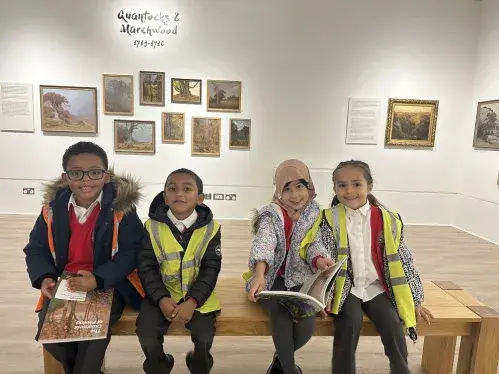Why do we learn art?
At Ayrton we believe a successful primary artist:
- develops an understanding of the formal elements of art
- can recognise, explain, create, and apply the formal elements within their own artwork
- explores a wide range of ideas, techniques, and processes
- takes inspiration from a variety of sources
- learns about the formal elements of line, shape, scale, space, form, pattern, composition, proportion, perspective, tone, texture, colour theory (primary, secondary, tertiary, harmonious, complementary, warm, cool)
- is given the opportunity to see art in the ‘real world’ by learning about careers linked to it and visiting art
- galleries and art instillations
Our approach
Implementation
Medium term plans are produced with the ‘Key knowledge’ and skills that children need to learn, with a strong emphasis on progression, artistic mediums, and artists.
Our Art curriculum:
- is taught through the process of a termly project linked to the children’s
- History learning, in order to enable connections between knowledge to be deepened
- allows children to gain a perspective of the artwork via learning about an artist or the inspiration behind the medium
- develop their ideas from looking at examples of concepts or the artist’s work
Impact
The impact of our curriculum is measured in terms of the extent to which children have developed new knowledge, understanding and skills, that they can use and apply effectively. This is measured by:
- teachers using a variety of strategies such as regular and consistent feedback
- the use of individual sketchbooks to evaluate the knowledge, skills and understanding that our children have gained in art during each half-termly unit.
Enrichment
In addition to the Art curriculum, enrichment is offered through:
- Planned trips to Art galleries
- Visitors
- Workshops
Curriculum Overview
Reception
In Reception, students explore, use, and refine a variety of artistic effects to express their ideas and feelings. They return to and build on their previous learning, refining ideas and developing their ability to represent them. They create collaboratively, sharing ideas, resources, and skills; and develop their small motor skills so that they can use a range of tools competently, safely, and confidently.
| Autumn | |
|---|---|
|
Who am I? Drawing How do we celebrate? Colour Exploration: Changes |
| Spring | |
|---|---|
|
Paws and Claws: painting Big and Small: street art Exploration: Sustainability |
| Summer | |
|---|---|
|
What’s out there? Pastels What lies beneath? Painting Exploration: Changes and Exploration |
Year 1
| Autumn | |
|---|---|
|
Toys throughout time: Drawing and Textiles To develop a wide range of art and design techniques in using colour, pattern, texture, line, shape, form and space |
| Spring | |
|---|---|
|
Knights and their castles: Collage To use a range of materials creatively to design and make products |
| Summer | |
|---|---|
|
People who change the World: Printing and Painting Learn about the work of a range of artists, craft makers and designers, describing the differences and similarities between different practices and disciplines, and making links to their own work. |
Year 2
| Autumn | |
|---|---|
|
Great Fire of London: Drawing To develop a wide range of art and design techniques in using colour, pattern, texture, line, shape, form and space |
| Spring | |
|---|---|
|
Around the World in 80 days: Clay and Collage To use a range of materials creatively to design and make products |
| Summer | |
|---|---|
|
On the Ocean Wave: Textiles and Printing Learn about the work of a range of artists, craft makers and designers, describing the differences and similarities between different practices and disciplines, and making links to their own work |
Year 3
| Autumn | |
|---|---|
|
Stone, Iron and Bronze Ages: Painting and Wall art design To create sketchbooks to record their observations and use them to review and revisit ideas |
| Spring | |
|---|---|
|
Greeks: Mosaic and Clay vases To improve their mastery of art and design techniques, including drawing, painting, and sculpture with a range of materials, (e.g. pencil, charcoal, paint, clay). |
| Summer | |
|---|---|
|
Egyptians: Sculpture and Printing To know about great artists, architects and designers in history. |
Year 4
| Autumn | |
|---|---|
|
Mayans: Drawing and Sculpture To create sketchbooks to record their observations and use them to review and revisit ideas |
| Spring | |
|---|---|
|
Roman Empire in Britain: Painting and Collage To improve their mastery of art and design techniques, including drawing, painting, and sculpture with a range of materials, (e.g. pencil, charcoal, paint, clay). |
| Summer | |
|---|---|
|
Anglo Saxons and Scots to Vikings: Printing and Textiles To know about great artists, architects and designers in history. |
Year 5
| Autumn | |
|---|---|
|
Tudor England: Drawing and Textiles To create sketchbooks to record their observations and use them to review and revisit ideas |
| Spring | |
|---|---|
|
Victorians: Printing and Textiles To improve their mastery of art and design techniques, including drawing, painting, and sculpture with a range of materials, (e.g. pencil, charcoal, paint, clay). |
| Summer | |
|---|---|
|
World War One: Painting and Sculpture To know about great artists, architects and designers in history. |
Year 6
| Autumn | |
|---|---|
|
World War Two: Drawing and Sculpture To create sketchbooks to record their observations and use them to review and revisit ideas |
| Spring | |
|---|---|
|
Equality and Diversity in Modern Britain: Collage and Printing To improve their mastery of art and design techniques, including drawing, painting, and sculpture with a range of materials, (e.g. pencil, charcoal, paint, clay). |
| Summer | |
|---|---|
|
Equality and Diversity in Modern Britain: Painting and Textiles To know about great artists, architects and designers in history. |
